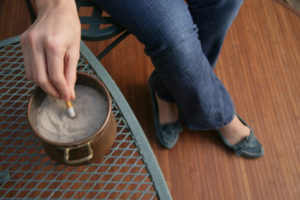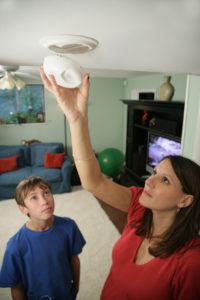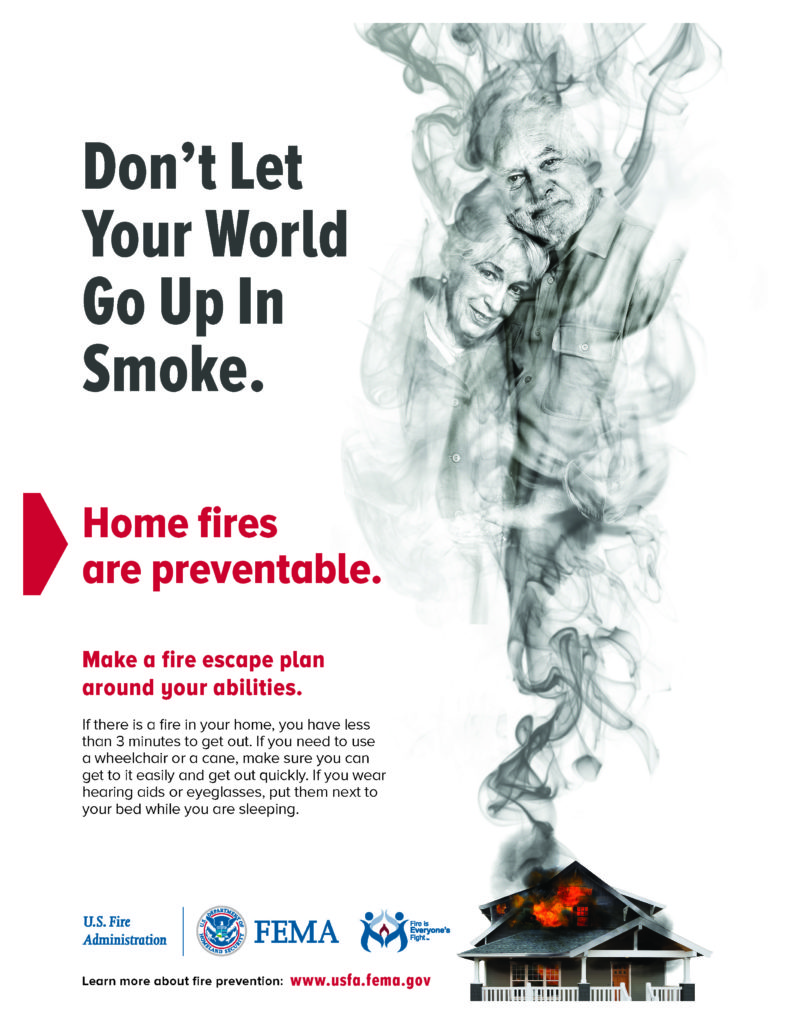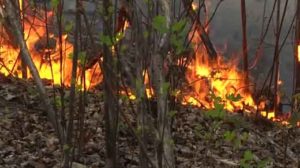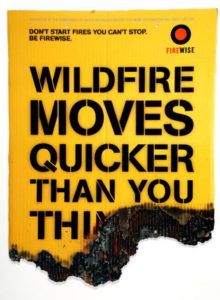Fires in the Home
In just two minutes, a fire can become life-threatening. In five minutes, a residence can be engulfed in flames Fire is FAST! In less than 30 seconds a small flame can turn into a major fire. It only takes minutes for thick black smoke to fill a house or for it to be engulfed in flames. Fire is HOT! Heat is more threatening than flames. Room temperatures in a fire can be 100 degrees at floor level and rise to 600 degrees at eye level. Inhaling this super-hot air will scorch your lungs and melt clothes to your skin.
Fire is DARK! Fire starts bright, but quickly produces black smoke and complete darkness.
Fire is DEADLY! Smoke and toxic gases kill more people than flames do. Fire produces poisonous gases that make you disoriented and drowsy. Asphyxiation is the leading cause of fire deaths, exceeding burns by a three-to-one ratio.
Home fires are preventable! The following are simple steps that each of us can take to prevent a tragedy.
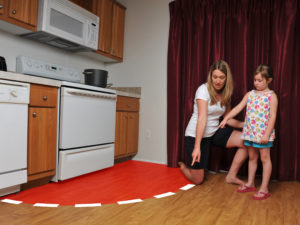 Cooking
Cooking
Stay in the kitchen when you are frying, grilling, or broiling food. If you leave the kitchen for even a short period of time, turn off the stove.
Wear short, close-fitting or tightly rolled sleeves when cooking.
Keep children away from cooking areas by enforcing a “kid-free zone” of 3 feet around the stove.
Position barbecue grills at least 10 feet away from siding and deck railings, and out from under eaves and overhanging branches.
Smoking
Smoke outside and completely stub out butts in an ashtray or a can filled with sand.
Soak cigarette butts and ashes in water before throwing them away. Never toss hot cigarette butts or ashes in the trash can.
Never smoke in a home where oxygen is used, even if it is turned off. Oxygen can be explosive and makes fire burn hotter and faster.
Be alert – don’t smoke in bed! If you are sleepy, have been drinking, or have taken medicine that makes you drowsy, put your cigarette out first.
Electrical and Appliance Safety
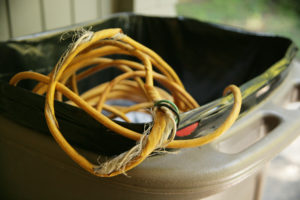 Frayed wires can cause fires. Replace all worn, old or damaged appliance cords immediately and do not run cords under rugs or furniture.
Frayed wires can cause fires. Replace all worn, old or damaged appliance cords immediately and do not run cords under rugs or furniture.
If an appliance has a three-prong plug, use it only in a three-slot outlet. Never force it to fit into a two-slot outlet or extension cord.
Immediately shut off, then professionally replace, light switches that are hot to the touch and lights that flicker.
Portable Space Heaters
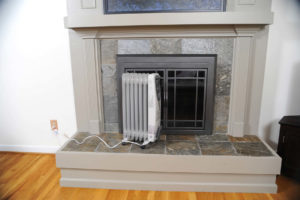
Keep combustible objects at least three feet away from portable heating devices.
Buy only heaters evaluated by a nationally recognized laboratory, such as Underwriters Laboratories (UL).
Check to make the portable heater has a thermostat control mechanism, and will switch off automatically if the heater falls over.
Only use crystal clear K-1 kerosene in kerosene heaters. Never overfill it. Use the heater in a well-ventilated room.
Fireplaces and Woodstoves
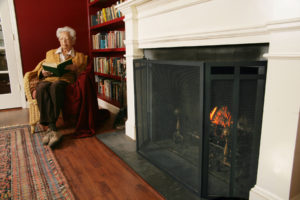 Inspect and clean woodstove pipes and chimneys annually and check monthly for damage or obstructions.
Inspect and clean woodstove pipes and chimneys annually and check monthly for damage or obstructions.
Use a fireplace screen heavy enough to stop rolling logs and big enough to cover the entire opening of the fireplace to catch flying sparks.
Make sure the fire is completely out before leaving the house or going to bed.
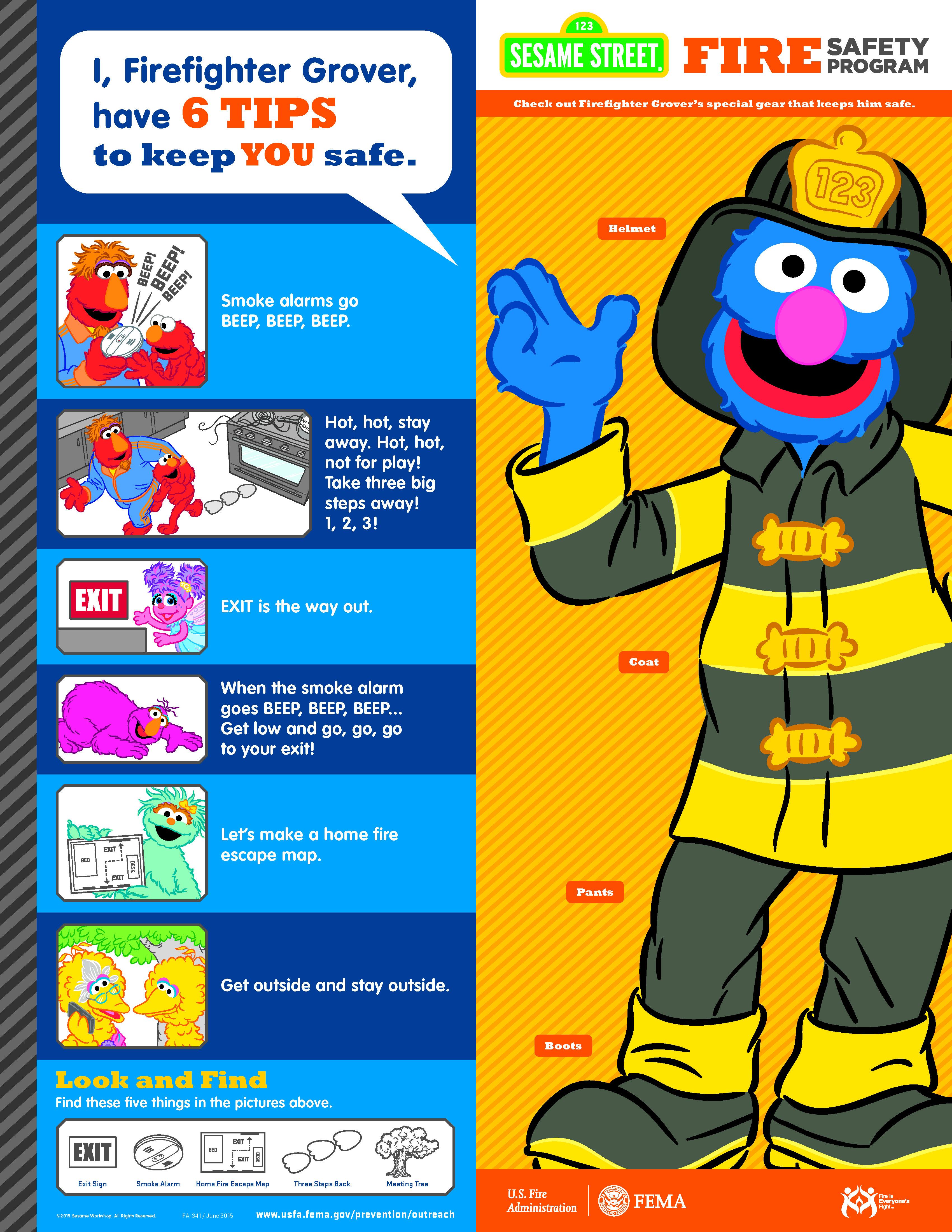
Children
Take the mystery out of fire play by teaching children that fire is a tool, not a toy.
Store matches and lighters out of children’s reach and sight, preferably in a locked cabinet.
Never leave children unattended near operating stoves or burning candles, even for a short time.
More Prevention Tips
Never use stove range or oven to heat your home.
Keep combustible and flammable liquids away from heat sources.
Portable generators should NEVER be used indoors and should only be refueled outdoors or in well ventilated areas.
Home Fire Safety
Create and Practice a Fire Escape Plan
In the event of a fire, remember that every second counts, so you and your family must always be prepared. Escape plans help you get out of your home quickly.
Twice each year, practice your home fire escape plan. Some tips to consider when preparing this plan include:
- Find two ways to get out of each room in the event the primary way is blocked by fire or smoke.
- A secondary route might be a window onto a neighboring roof or a collapsible ladder for escape from upper story windows.
- Make sure that windows are not stuck, screens can be taken out quickly, and that security bars can be properly opened.
- Practice feeling your way out of the house in the dark or with your eyes closed.
- Teach children not to hide from firefighters.
Smoke Alarms
A working smoke alarm significantly increases your chances of surviving a deadly home fire.
Install both ionization AND photoelectric smoke alarms, OR dual sensor smoke alarms, which contain both ionization and photoelectric smoke sensors.
Test batteries monthly.
Replace batteries in battery-powered and hard-wired smoke alarms at least once a year (except non-replaceable 10-year lithium batteries).
Install smoke alarms on every level of your home, including the basement, both inside and outside of sleeping areas.
Replace the entire smoke alarm unit every 8-10 years or according to manufacturer’s instructions.
Never disable a smoke alarm while cooking – it can be a deadly mistake.
More Fire Safety Tips
Make digital copies of valuable documents and records like birth certificates.
Sleep with your door closed.
Contact your local fire department for information on training on the proper use and maintenance of fire extinguishers.
Consider installing an automatic fire sprinkler system in your residence.
Considerations for Those with Disabilities
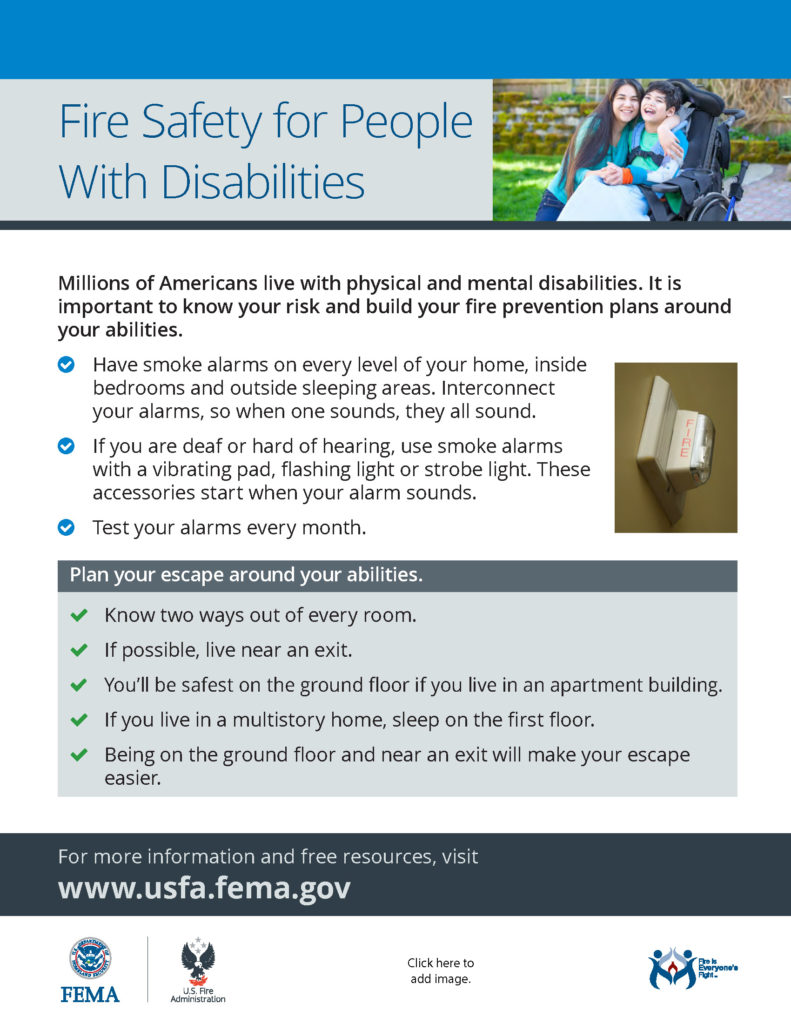 Millions of Americans live with physical and mental disabilities. It is important for them to know the steps they can take to stay safe from fire. Put these fire safety messages into your own words when talking to people with disabilities about fire safety.
Millions of Americans live with physical and mental disabilities. It is important for them to know the steps they can take to stay safe from fire. Put these fire safety messages into your own words when talking to people with disabilities about fire safety.
Understand your fire risk
Having physical or mental disabilities does not mean you are unable to take the important steps to keep you and your family safe from fire.
Build your fire prevention plans around your abilities.
Install and maintain smoke alarms
Smoke alarms with a vibrating pad or flashing light are available for people who are deaf or hard of hearing.
Smoke alarms with a strobe light outside the home to catch the attention of neighbors, and emergency call systems for summoning help, are also available.
Ask the manager of your building, or a friend or relative, to install at least one smoke alarm on each level of your home.
Test smoke alarm batteries every month and change them at least once a year. If you can’t reach the test button on your smoke alarm, ask someone to test it for you.
Live near an exit
Although you have the legal right to live where you choose, you’ll be safest on the ground floor if you live in an apartment building.
If you live in a multistory home, arrange to sleep on the first floor.
Being on the ground floor and near an exit will make your escape easier.
Plan your escape
Plan your escape around your capabilities.
Know at least two exits from every room.
If you use a walker or wheelchair, check all exits to be sure you can get through the doorways.
Make any necessary changes, such as installing exit ramps and widening doorways, to make an emergency escape easier.
Don’t isolate yourself
Speak to your family members, building manager or neighbors about your fire safety plan and practice it with them.
Contact your local fire department’s nonemergency line and explain your needs. They can suggest escape plan ideas and may perform a home fire safety inspection if you ask.
Ask emergency providers to keep your needs information on file.
Keep a phone near your bed and be ready to call 911 or your local emergency number if a fire occurs.
Wildfires
Risk
Wildfires can occur anywhere and can destroy homes, businesses, infrastructure, natural resources, and agriculture. For more information, download the How to Prepare for a Wildfire guide, which provides the basics of wildfires, explains how to protect yourself and your property, and details the steps to take now so that you can act quickly when you, your home, or your business is in danger.
What
A wildfire is an unplanned, unwanted fire burning in a natural area, such as a forest, grassland, or prairie. As building development expands into these areas, homes and businesses may be situated in or near areas susceptible to wildfires. This is called the wildland urban interface.
Wildfires can cause death or injury to people and animals, damage or destroy structures, and disrupt community services including transportation, gas, power, communications, and other services. The impact may cover large areas with extensive burning, embers traveling more than a mile away from the wildfire itself, and smoke causing health issues for people far away from the fire. Wildfires damage watersheds leave areas prone to flooding and mudslides for many years.
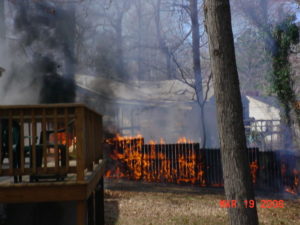 Where
Where
Wildfires can occur anywhere in the country. They can start in remote wilderness areas, in national parks, or even in your back yard. Wildfires can start from natural causes, such as lightning, but most are caused by humans, either accidentally—from cigarettes, campfires, or outdoor burning—or intentionally.
When
Wildfires can occur at any time throughout the year, but the potential is always higher during periods with little or no rainfall, which make brush, grass, and trees dry and burn more easily. High winds can also contribute to spreading the fire. Your community may have a designated wildfire season when the risk is particularly high.
Fire Weather Watch / Warning
Fire weather watch: dangerous fire weather conditions are possible over the next 12 to 72 hours
Red flag warning: dangerous fire weather conditions are occurring, imminent or are expected to occur with the next 24 hours. These warning are issued when fuel moisture levels are low (generally less than 7%), relative humidity is low (less than 30%) and sustained winds are greater than 20 mph.
Steps to Take
Turn on your TV/radio. You’ll get the latest weather updates and emergency instructions.
Know where to go. If you are ordered to evacuate, know the route to take and have plan of where you will go. Check-in with your friends and family.
Keep your car fueled, in good condition, and stocked with emergency supplies and a change of clothes.
Before Wildfire season
Make a Wildfire plan
Know your wildfire risk.
Familiarize yourself with local emergency plans. Know where to go and how to get there should you need to evacuate.
Make a wildfire emergency plan, including an evacuation plan and a communication plan.
Build or restock your emergency preparedness kit, including a flashlight, batteries, cash, and first aid supplies.
Stay tuned to your phone alerts, TV, or radio, for weather updates, emergency instructions or evacuation orders.
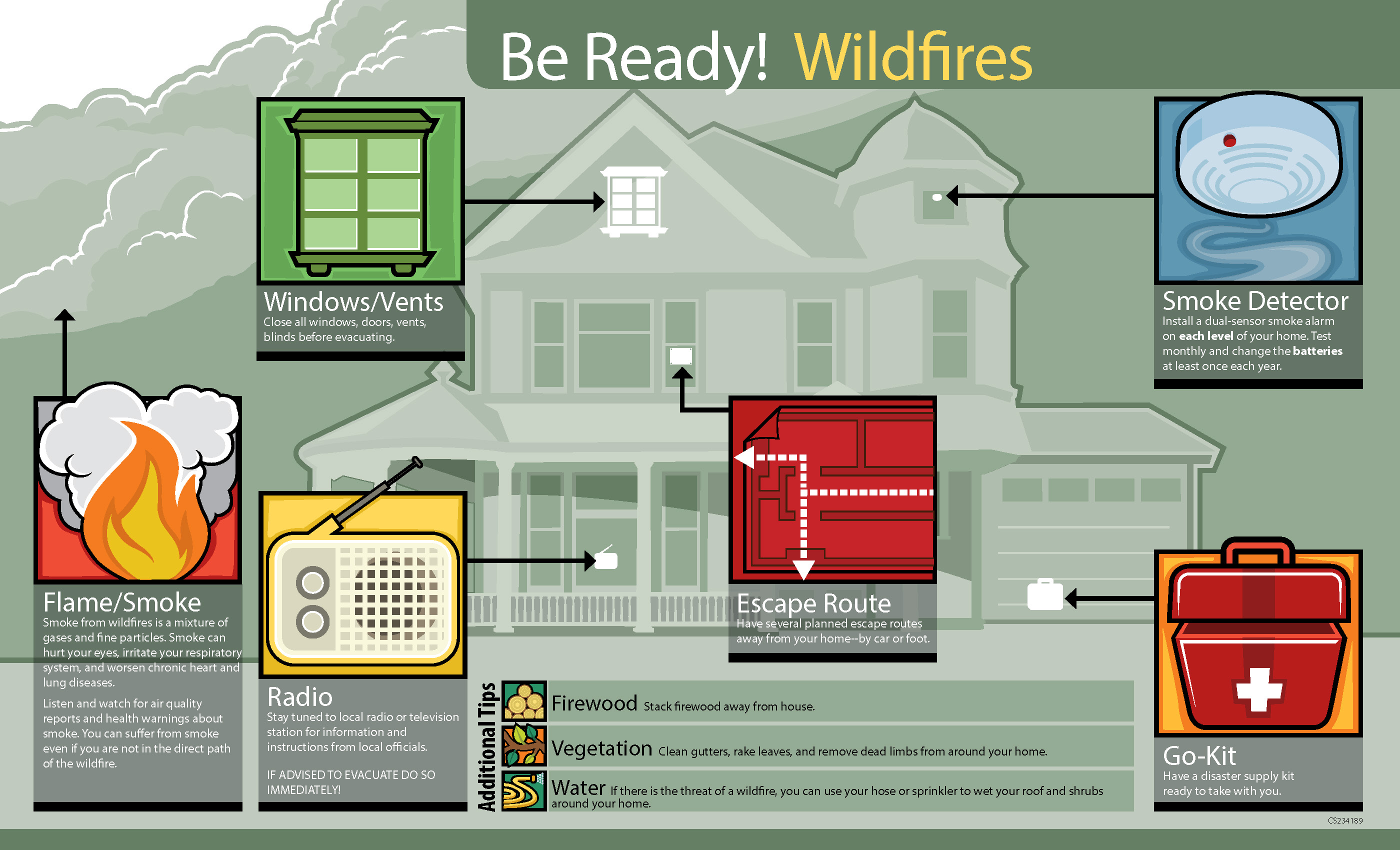 Prepare Your Home
Prepare Your Home
Create and maintain an area approximately 30’ away from you home that is free of anything that will burn, such as wood piles, dried leaves, newspapers, brush, and other landscaping that can burn. From 30 feet to 100 feet reduce or replace as much of the most flammable vegetation as possible and prune vegetation, create “fuel breaks,” such as driveways, gravel walkways, and lawns. Work with neighbors to create spaces up to 200 feet around your homes where vegetation is thinned to remove underbrush and tall trees do not touch each other for continuous canopies.
Regularly clean the roof and gutters.
Connect garden hoses long enough to reach any area of the home and fill garbage cans, tubs, or other large containers with water.
Review your homeowner’s insurance policy and also prepare/update a list of your home’s contents.
During a Wildfire
If there is a wildfire in the area, be ready to evacuate on short notice.
If you see a wildfire and haven’t received evacuation orders yet, call 9-1-1. Don’t assume that someone else has already called.
If ordered to evacuate during a wildfire, do it immediately- make sure and tell someone where you are going and when you have arrived.
If you or someone you are with has been burned, call 9-1-1 or seek help immediately; cool and cover burns to reduce chance of further injury or infection.
After a Wildfire
Returning Home
- Return home only when authorities say it is safe.
- For several hours after the fire, maintain a “fire watch.” Check and re-check for smoke, sparks or hidden embers throughout the house, including the roof and the attic.
- Use caution when entering burned areas as hazards may still exist, including hot spots, which can flare up without warning. Evacuate immediately if you smell smoke.
Cleaning Your Home
- Wear a NIOSH certified-respirator (dust mask) and wet debris down to minimize breathing dust particles.
- Discard any food that has been exposed to heat, smoke or soot.
- Do NOT use water that you think may be contaminated to wash dishes, brush teeth, prepare food, wash hands, or to make ice or baby formula.
- Photograph damage to your property for insurance purposes.
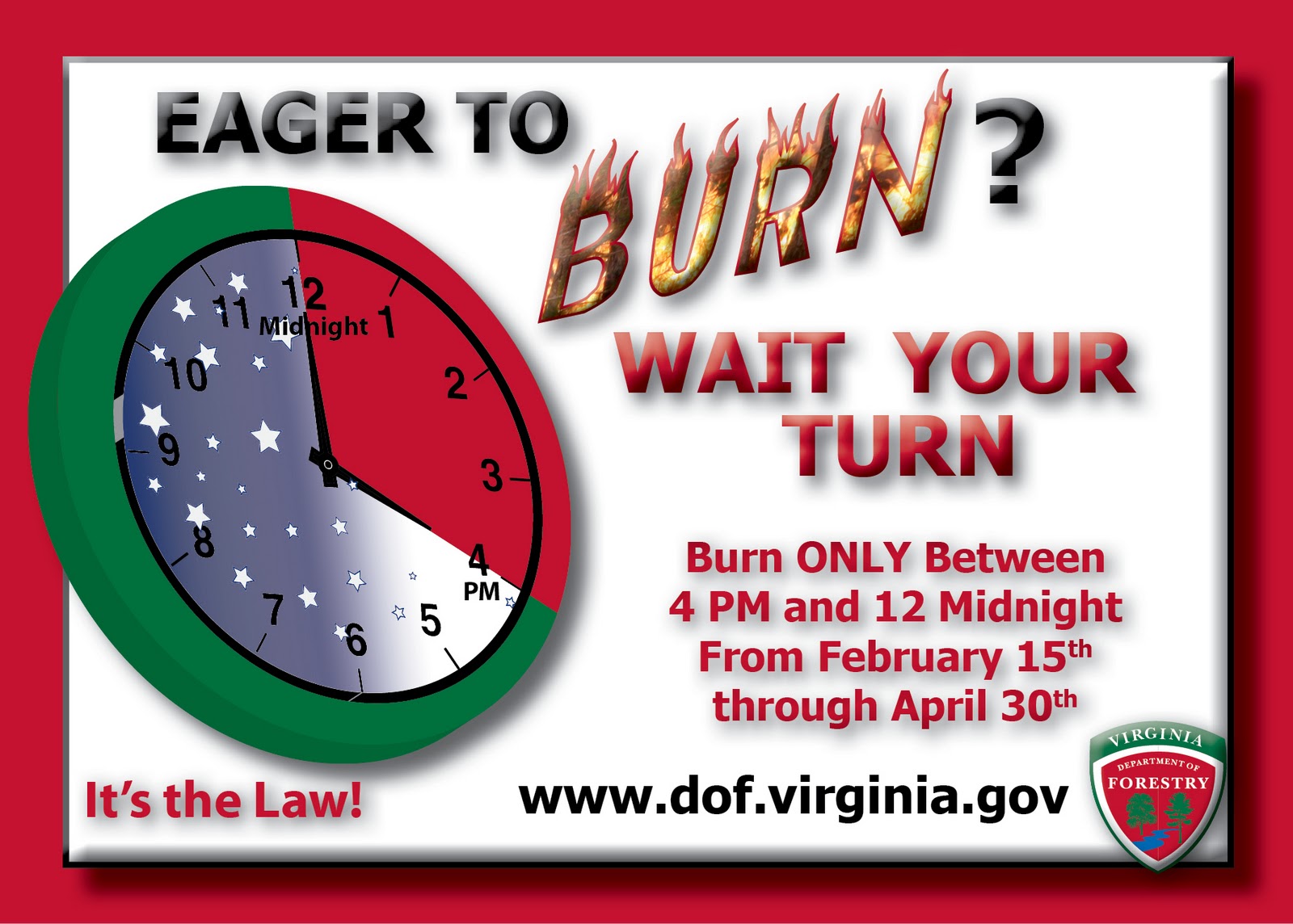 Spring Fire Season
Spring Fire Season
The 4 p.m. Law is a ban (or restriction) on open air burning before 4 p.m. if your fire is within 300 feet of the woods or dry grass which can carry the fire to the woods. You are allowed to burn between 4 p.m. and midnight as long as you take proper care and precaution and attend your fire at all times.
Why is there a 4 p.m. Law? When is the 4 p.m. Law in effect?
The law goes into effect on February 15th each year and runs through April 30th.
Why is there a 4 p.m. Law?
The 4 p.m. Law was adopted during the 1940’s to reduce the number of wildfires which occurred each spring. During this time of the year, Virginia traditionally has an increased number of fires. During the winter months, winds are usually elevated, the relative humidity is lower and the fuels on the forest floor are extremely dry, having “cured” without having the tree leaves to shade them.
Why 4 p.m.?
After 4 p.m., winds usually calm down and the relative humidity levels are on the increase, both of which reduce the potential for a debris fire or any outdoor open air fire to escape your control.
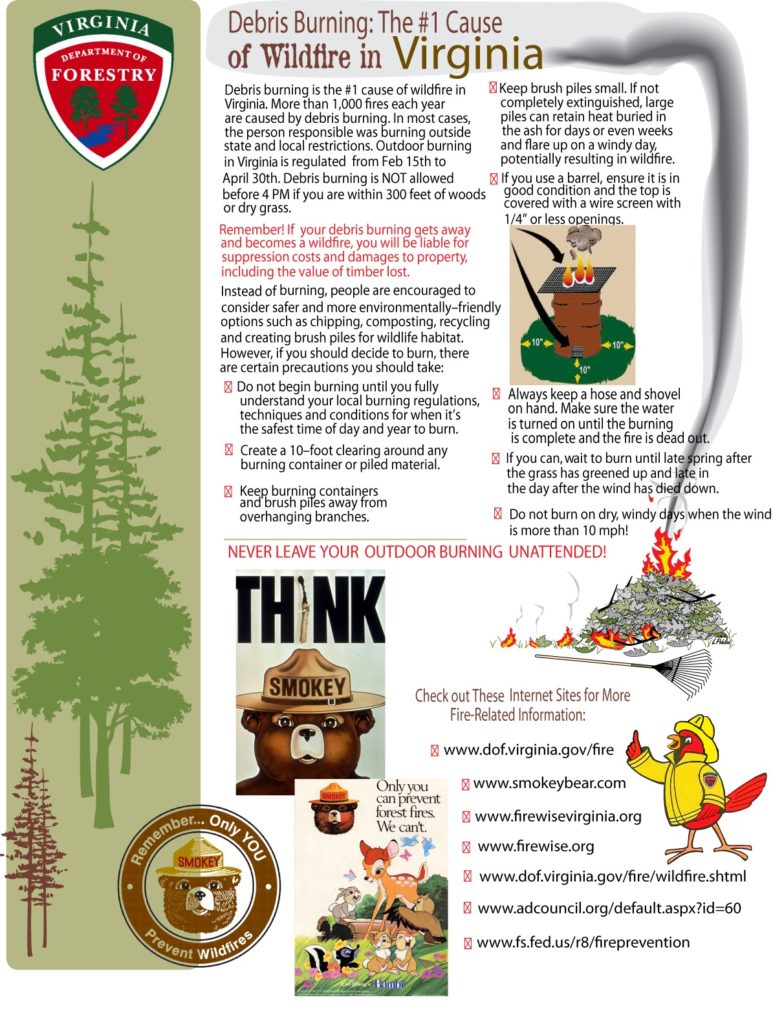 What is the main cause of wildfires in Virginia?
What is the main cause of wildfires in Virginia?
Debris burning is the leading cause of wildfires, closely followed by intentionally set or “arson” fires.
How many wildfires burn in Virginia each year and how many acres are burned?
Virginia has records which date back to 1925, and our 30 year average is 1,449 fires for 8,338 acres per year. 1941 saw the most fires with 3,697, and 1930 had the most acreage burned at 333,023 acres.
Can I have a campfire if I put rocks around it?
No, campfires are considered an open air fire. A pit fire or campfire may be approved if it meets all of the following conditions: Fire is below ground level, continuously monitored, completely enclosed with cinder blocks, and a ¼” or smaller metal screen is placed over the enclosure. Extra precautions should be taken to clear a 20-foot circle of all flammable materials and have water and a shovel available.
If I take all precautions with my fire after 4 p.m. and it does escape and start a fire, am I responsible for the suppression cost?
Yes. Although you may have taken all proper precautions and obtained any locally required permits, whoever started the fire is responsible should the fire escape.
What is the penalty for violating the 4 p.m. law?
Violation of the 4 p.m. law is a class 1 misdemeanor punishable with up to 1 year in jail and/or a fine of not more than $2,500.
Can I use my charcoal or gas fire fired barbeque grill?
Yes, however you must take proper care and precaution by clearing all flammable material from around it and you must stay with it until it is completely extinguished or turned off.
Are building contractors and road construction jobs exempt from the 4 p.m. law?
No, however those burning operations must also have an operational fire permit from the Fire Prevention Office prior to conducting burning operations at any time.

